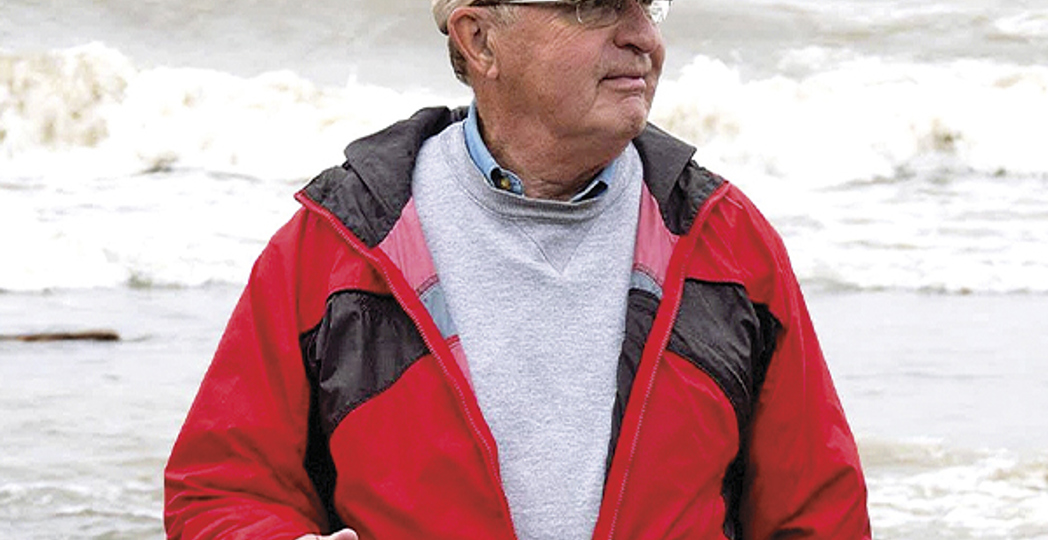Rocky River Author Shares Lakefront Discoveries
Thomas MacFarLand Harper highlights details of his new book, "Ancient Native American Stone Faces and Other Local Artifacts of Rocky River, Ohio."
by Jill Sell | May. 1, 2021 | 4:00 AM

The sun is just rising over the Lake Erie horizon. A man walks along the beach, eyes down and alert, making sure no interesting stone is left unturned. Rocky River resident Thomas MacFarLand Harper was a familiar figure at Bradstreet’s Landing, a city-owned park with a 596-foot-long pier, until recent construction closed the area to the public. The 78-year-old Harper has written a self-published book about his discoveries, “Ancient Native American Stone Faces and Other Local Artifacts of Rocky River, Ohio.”
According to Ohio History Central, Ohio was a leading center for Native American trade in the prehistoric era and a “battleground for the frontier” during the 18th and early 19th centuries. Harper believes many of his artifacts have an Iroquois origin from the Fort Ancient period, 1000 A.D.
Harper has found pieces of Native American tobacco pipes, pottery bits, tool-making stones and stone gaming pieces. Also in his extensive collection are animal shapes made from pewter that most likely was sunk aboard British longboats during the historic Bradstreet’s Disaster in 1764. Native Americans reworked the bits of pewter into shapes of snakes, birds and foxes, says Harper.
Harper finds the stones with faces most fascinating. Most of the small stones have two human eyes and a rounded mouth made by drilling. Some stones also show ear indentions, tongues, chins and pebbles placed in holes for eyeballs. Harper named one stone the Weeping Eye Stone and believes it shows faces of two grieving parents, as well as a child’s face. Because Harper’s 8-year-old daughter died in 1983, he considers the stone to have “the most powerful narrative” of all of the stones in his collection.
“I’m not a professional archaeologist,” says Harper, who is, however, a charter member of the Cleveland Fossil Society and the North Coast Fossil Society, as well as a member of the Ohio Archaeological Society. “These face stones were probably talismans or amulets to Native Americans, believing they had protective qualities besides being magical and good luck charms.”
In talking with Native Americans and based on his own observations, Harper thinks the stone faces may have served as dream catchers to protect against “mental or physical disturbances of bad dreams.” Harper says DNA results have shown his mother to have some “indigenous American Indian” heritage.
Harper, an insurance agent with Evarts Tremaine, readily admits that not all professional archaeologists agree with his assessments. Some professionals suggest that stones like these represent a tendency called pareidolia in which humans see faces or patterns in objects including clouds or rock formations. However, Harper is steadfast in his belief that the stone faces are human-made and not occurring naturally in the environment.
“Sometimes, I like to look for stones late in the day when the sun hits them at a different angle. I might have missed something in the morning,” says Harper. “I look for holes in the stone and the drill work. I turn it over and maybe there is a face. I wrote my book to let people know what they can find along the lake.”
Harper’s first book, “Rocky River, Ohio: Where the River Ends,” raised more than $25,000 for Rocky River Historical Society. He’s also given some pieces from his rock and fossil collections to the society, as well as Libby Museum in Wolfeboro, New Hampshire.
“Ancient Native American Stone Faces and Other Local Artifacts of Rocky River, Ohio,” $25, is available at Rego Brothers Lake Road Market, E & H Ace Hardware and Pier Beverage and Deli, all in Rocky River.
Looking to uncover treasures such as the ones Harper finds? He suggests visiting Huntington Beach or Columbia Park, both located in Bay Village, as well as Veterans Memorial Park in Avon Lake.
Trending
-
1
-
2
-
3
-
4
-
5










